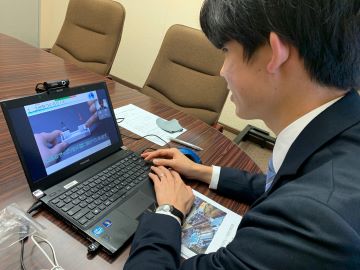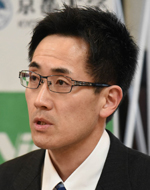Our Contributions to Society
Nidec’s Contribution in Education
The Nidec Group is contributing in the area of education through the following activities:
Environmental and motor-making classes


To promote children’s interest and understanding on the global environment and science, we visit various regions’ elementary schools and other learning facilities to hold environment and craft-making classes.
Nidec launched environmental classes for elementary school children in the city of Kyoto 17 years ago, in 2007. To prevent the spread of the coronavirus, we have introduced online remote classes since FY2020. In FY2022, We held a motor class 5 times for a total of 219 elementary school students in Japan’s Kyoto Prefecture, to teach them, among other things, how motors used in our daily lives work and motors’ relations with electric energy, while thinking with them what they can do for the global environment, and showing them the future of motors that Nidec aims to create. These elementary school students made motors themselves as well, to experience the fun of making things.
Nidec Opens an Endowment Class, “Advance Electrical Equipment to Realize a Friendly Global Environment,” at Kyoto University’s Graduate School of Engineering
In April 2017, Nidec and Kyoto University founded an endowment class, “Advanced Electrical Equipment to Realize a Friendly Global Environment,” to support the future global environment’s sustainable growth via advanced electrical equipment research and development, and train young researchers to gain expertise in the area.
This Nidec-supported endowment class aims to integrate multiple different academic fields by engaging students in the technological research and development of innovative electrical equipment to realize a sustainable global environment. Such R&D activities, which will highly likely make significant contributions to a variety of areas ranging from basic science to industrial application, will prove effective in providing graduate students with research guidance, and training young, next-generation researchers.
Interview with Program-Specific Professor Taketsune Nakamura of Kyoto University’s Graduate School of Engineering

Program-Specific Professor
Taketsune Nakamura
of Kyoto University’s
Graduate School of Engineering
We interviewed Program-Specific Professor Taketsune Nakamura (“Professor Nakamura”) of Kyoto University’s Graduate School of Engineering, who teaches at an endowment class, “Advanced Electrical Equipment Engineering that Realizes an Ecofriendly Global Environment.” In this interview to ask his views on motor research and its future outlook, Professor Nakamura told us about his passion of “communicating to the next generation that motors are academic and fascinating devices.”
Q How was the endowment class founded?
A “As I understand, the class was founded based on the relations between Professor Juichi Yamagiwa, President of Kyoto University, and Mr. Shigenobu Nagamori, Chairman of Nidec Corporation. As I was the only motor researcher at the university, it appointed me to teach the class upon its foundation.”
Q Please explain what “research and development of advanced electrical equipment” is.
A
“To answer the question, I need to explain what students research in this class. My initial research involved motor development research using superconductive materials (certain types of ceramics and other materials whose electrical resistance get extremely close to zero at ultralow temperatures). This is a ‘hardware-side’ research to enhance the efficiency of the motor itself; in the endowment class, however, we engage in ‘software-side’ researches as well, to control the motor’s movements efficiently.”
“We utilize two methods to control motors: The first method is for the motor to autonomously control itself. For example, let’s say motors are used for an automobile’s tires. If the car gets stuck in mud, and as its driver presses on the accelerator to get out, an excess amount of electricity will run through the motors, burning them. The method enables motors to control themselves to avoid being subject to electricity beyond their capacity. This is a so-called ‘control from the inside.’
“The second method is to use IoT, etc. to control multiple motors in a coordinated way. Once again, in a case of motors for an automobile’s tires, this method enables to control all the four motors via a communication function for the tires to rotate in synchronization with one another, or for only the front tires to rotate more than the others, etc. This is a ‘control from the outside.’
“In other words, the motors in these examples are leading-edge electrical equipment that use state-of-the-art technologies on both hardware and software sides.”
Q In your research on “Intelligent Electrical Equipment and Its Systemization,” do you research on high-efficiency motors with controlling functions, which you have explained to us when referring to your “software-side” research?
A
“Yes, but motors are not the only focus of my research. Operating motors requires connecting them to various devices: First, you connect an inverter to a motor, to whose tip you connect a device that the motor operates. All of these devices are controlled by communication equipment. Researching individual devices and phenomena requires study in individual academic areas: electric and electronic study for inverters, electromagnetics for motors, mechanics for motor-driven devices (i.e. compressors), information theory for information devices, etc.”
“Nonetheless, I am trying to create a field of study that unifies and integrates these fields – This is a kind of ‘multi-physics,’ which regards different kinds of physics as one form of academic field; for example, seeking motor efficiency solely from an electromagnetics viewpoint does not necessarily help an inverter or a compressor to achieve its maximum efficiency. In some circumstances, though the motor’s performance efficiency may not be the best, the performance of the entire equipment, including the inverter and the compressor, may achieve the maximum efficiency output. The academic field I am trying to create is to seek not a partial but the total optimization of equipment.”
Q Is it correct to say that, while Nidec conducts hardware side-related researches to seek the maximum efficiency of the motor itself, you research on the software side to seek the maximum efficiency of an entire system, including the motor and its peripheral system, and that the two parties exchange information with each other on their researches?
A “You are overall correct, but it is not that Kyoto University’s researchers do not research on the hardware side: Some students are researching to revise the motor’s rotation theory itself. All types of motors were born in the 19th century, and various motor theories are established already; however, there is yet to be a “comprehensive theory that applies to any and all types of motors.” That is, I would like to research an area where there are only individual theories, to create one that unifies them all.”
Q Your laboratory, I believe, can be represented by such words “comprehensive,” “unification,” and “general theory.”
A “I think that the view is correct. The area of motor research has yet to have a study that researches not individual theories or parts thereof, but all of them comprehensively. In that regard, I believe, the motor is an extremely academic and intriguing device. I strongly hope to teach this fact to younger generations, who should be interested in motors.”

